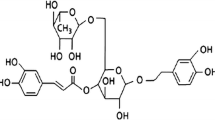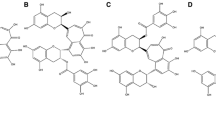Abstract
Sodium nitroprusside (SNP) is a widely used nitric oxide (NO) donor, known to exert nitrative stress by up-regulation of inducible nitric oxide synthase (iNOS). Nω-nitro-l-arginine-methyl esther (L-NAME) is a NO inhibitor, which inhibits iNOS expression, is used as positive control. The present study was designed to assess neuroprotective propensity of Bacopa monniera extract (BME) in SNP-induced neuronal damage and oxido-nitrative stress in PC12 cells via modulation of iNOS, heat shock proteins and apoptotic markers. Our results elucidate that pre-treatment of PC12 cells with BME ameliorates the mitochondrial and plasma membrane damage induced by SNP (200 μM) as evidenced by MTT and LDH assays. BME pre-treatment inhibited NO generation by down regulating iNOS expression. BME replenished the depleted antioxidant status induced by SNP treatment. SNP-induced damage to cellular, nuclear and mitochondrial integrity was also restored by BME, which was confirmed by ROS estimation, comet assay and mitochondrial membrane potential assays respectively. BME pre-treatment efficiently attenuated the SNP-induced apoptotic protein biomarkers such as Bax, Bcl-2, cytochrome-c and caspase-3, which orchestrate the proteolytic damage of the cell. Q-PCR results further elucidated up-regulation of neuronal cell stress markers like HO-1 and iNOS and down-regulation of BDNF upon SNP exposure was attenuated by BME pre-treatment. By considering all these findings, we report that BME protects PC12 cells against SNP-induced toxicity via its free radical scavenging and neuroprotective mechanism.










Similar content being viewed by others

References
Wink DA, Osawa Y, Darbyshire JF, Jones CR, Eshenaur SC, Nims RW (1993) Inhibition of cytochromes-P450 by nitric oxide and a nitric oxide-releasing agent. Arch Biochem Biophys 300:115–123
Davis KL, Martin E, Turko IV, Murad F (2001) Novel effects of nitric oxide. Annu Rev Pharmacol Toxicol 41:203–236
Briviba K, Klotz LO, Sies H (1999) Defenses against peroxynitrite. Methods Enzymol 301:391–411
Aoyama K, Matsubara K, Fujikawa Y, Nagahiro Y, Shimizu K, Umegae N, Hayase N, Shiono H, Kobayashi S (2000) Nitration of manganese superoxide dismutase in cerebrospinal fluids is a marker for peroxynitrite-mediated oxidative stress in neurodegenerative diseases. Ann Neurol 47:524–527
Chung KK, Dawson TM, Dawson VL (2005) Nitric oxide, S-nitrosylation and neurodegeneration. Cell Mol Biol 51:247–254
Russo A, Borrelli F (2005) Bacopa monniera, a reputed nootropic plant: an overview. Phytomed 12:305–317
Dash VB, Kashyap VL (1980) Materia medica of Ayurveda. Concept Publishing Company, New Delhi, pp 53–54
Singh HK, Dhawan BN (1997) Neuropsychopharmacological effects of the Ayurvedic nootropic Bacopa monniera Linn. (Brahmi). Ind J Pharmacol 29:359–365
Anand T, Naika Mahadeva, Swamy MSL, Khanum Farhath (2011) Antioxidant and DNA damage preventive properties of Bacopa monniera (L.) Wettst. Free Radic Antioxid 1:84–90
Tripathi YB, Chaurasia S, Tripathi E, Upadhyay A, Dubey GP (1996) Bacopa monniera Linn. as an antioxidant: mechanism of action. Ind J Exp Biol 34:523–526
Anand T, Phani Kumar G, Pandareesh MD, Swamy MSL, Khanum F, Bawa AS (2012) Effect of bacoside extract from Bacopa monniera on physical fatigue induced by forced swimming. Phytother Res 26:587–593
Channa S, Dar A, Anjum S, Yaqoob M, Rahman A (2006) Anti-inflammatory activity of Bacopa monniera in rodents. J Ethnopharmacol 104:286–289
Pandareesh MD, Anand T (2013) Neuromodulatory propensity of Bacopa monniera against Scopolamine-induced cytotoxicity in PC12 cells via down regulation of AChE and up regulation of BDNF and muscarnic 1 receptor expression. Cell Mol Neurobiol 33:875–884
Anand T, Bhanu Prakash K, Pandareesh MD, Farhath Khanum (2013). Development of bacoside enriched date syrup juice and its evaluation for physical endurance. J Food Sci Technol. doi:10.1007/s13197-013-0955-5
Mark RJ, Keller JN, Kruman I, Mattson MP (1997) Basic FGF attenuates amyloid β-peptide-induced oxidative stress, mitochondrial dysfunction, and impairment of Na+/K+-ATPase activity in hippocampal neurons. Brain Res 756:205–214
Ohkawa H, Ohishi N, Yagi K (1979) Assay for lipid peroxides in animal tissues by thiobarbituric acid reaction. Anal Biochem 95:351–358
Buege JA, Aust SD (1978) Microsomal lipid peroxidation. Methods Enzymol 52:301–310
Singh NP, McCoy MT, Tice RR, Schneider EL (1988) A simple technique for quantitation of low levels of DNA damage in individual cells. Exp Cell Res 175:184–191
Aebi H (1984) Catalase in vitro. Methods Enzymol 105:121–126
Roberta RE, Nicoletta P, Anna P, Ananth P, Yang M, Catherine RE (1999) Antioxidant activity applying an improved ABTS radical cation decolorization assay. Free Radic Biol Med 26:1231–1237
Wang H, Yu S-W, Koh DW, Lew J, Coombos C, Bowers W, Federoff HJ, Poirier GG, Dawson TM, Dawson VL (2004) Apoptosis-Inducing Factor Substitutes For Caspase Executioners in NMDA-triggered excitotoxic neuronal death. J Neurosci 24:10963–10973
Lowry OH, Rosenberg NJ, Farr AL, Randal RJ (1951) Protein measurement with Folin phenol reagent. J Biol Chem 193:265–275
Imam SZ, El-Yazal J, Newport GD, Itzhak Y, Cadet JL, Slikker W, Ali SF (2001) Methamphetamine-induced dopaminergic neurotoxicity: role of peroxynitrite and neuroprotective role of antioxidants and peroxynitrite decomposition catalysts. Ann NY Acad Sci 939:366–380
Pytlowany M, Strosznajder JB, Jesko H, Cakala M, Strosznajder RP (2008) Molecular mechanism of PC12 cell death evoked by sodium nitroprusside, a nitric oxide donor. Acta Biochim Pol 55:339–347
Ning N, Jin-feng HU, Yu-he Y, Xin-yuan Z, Jun-gui D, Nai-hong C (2012) Huperzine A derivative M3 protects PC12 cells against sodium nitroprusside-induced apoptosis. Acta Pharmacol Sin 33:34–40
Crow JP (1997) Dichlorodihydrofluorescein and dihydrorhodamine 123 are sensitive indicators of peroxynitrite in vitro: implications for intracellular measurement of reactive nitrogen and oxygen species. Nitric Oxide 1:145–157
Culmsee C, Gerling N, Landshamer S, Rickerts B, Duchstein HJ, Umezawa K, Klumpp S, Krieglstein J (2005) Nitric oxide donors induce neurotrophin-like survival signaling and protect neurons against apoptosis. Mol Pharmacol 68:1006–1017
Adamczyk A, Czapski GA, KaŸmierczak A, Strosznajder JB (2009) Effect of N-methyl-D-aspartate (NMDA) receptor antagonists on a-synuclein-evoked neuronal nitric oxide synthase activation in the rat brain. Pharmacol Rep 61:1078–1085
Motterlini R, Foresti R, Intaglietta M, Winslow RM (1996) NO-mediated activation of heme oxygenase: endogenous cytoprotection against oxidative stress to endothelium. Am J Physiol Heart Circ Physiol 270:107–114
Motterlini R, Foresti R, Bassi R, Calabrese V, Clark JE, Green CJ (2000) Endothelial heme oxygenase-1 induction by hypoxia modulation by inducible nitric-oxide synthase and s-nitrosothiols. J Biol Chem 275:13613–13620
Maines MD (1997) The heme oxygenase system: a regulator of second messenger gases. Ann Rev Pharmacol Toxicol 37:517–554
Foresti R, Motterlini R (1999) The heme oxygenase pathway and its interaction with nitric oxide in the control of cellular homeostasis. Free Radic Res 31:459–475
Murer MG, Yan Q, Raisman-Vozari R (2001) Brain-derived neurotrophic factor in the control human brain, and in Alzheimer’s disease and Parkinson’s disease. Prog Neurobiol 63:71–124
LeBel CP, Ischiropoulos H, Bondy SC (1992) Evaluation of the probe 2′,7′-dichlorofluorescin as an indicator of reactive oxygen species formation and oxidative stress. Chem Res Toxicol 5:227–231
Ly JD, Grubb DR, Lawen A (2003) The mitochondrial membrane potential (Δψm) in apoptosis; an update. Apoptosis 8:115–128
Ubl JJ, Chatton JY, Chen S, Stucki JW (1996) A critical evaluation of in situ measurement of mitochondrial electrical potentials in single hepatocytes. Biochim Biophys Acta 1276:124–132
Hruszkewycz AM (1992) Lipid peroxidation and mtDNA degeneration. A hypothesis. Mutat Res 275:243–248
Kim YM, Bergonia H, Lancaster JR (1995) Nitrogen oxide-induced autoprotection in isolated rat hepatocytes. FEBS Lett 374:228–232
Fehsel K, Kroncke KD, Meyer KL, Huber H, Wahn V, Kolb-Bachofen V (1995) Nitric oxide induces apoptosis in mouse thymocytes. J Immunol 155:2858–2865
Von Knethen A, Callsen D, Brune B (1999) NF-B and AP-1 activation by nitric oxide attenuated apoptotic cell death in RAW 264.7 macrophages. Mol Biol Cell 10:361–372
Kirkinezos IG, Moraes CT (2001) Reactive oxygen species and mitochondrial diseases. Semin Cell Dev Biol 12:449–457
Li JL, Wang QY, Luan HY, Kang ZC, Wang CB (2012) Effects of L-carnitine against oxidative stress in human hepatocytes: involvement of peroxisome proliferator-activated receptor alpha. J Biomed Sci 19:32
Merad-Boudia M, Nicole A, Santiard-Baron D, Saille C, Ceballos-Picot I (1998) Mitochondrial impairment as an early event in the process of apoptosis induced by glutathione depletion in neuronal cells: relevance to Parkinson’s disease. Biochem Pharmacol 56:645–655
Ibi M, Sawada H, Kume T, Katsuki H, Kaneko S, Shimohama S, Akaike A (1999) Depletion of intracellular glutathione increases susceptibility to nitric oxide in mesencephalic dopaminergic neurons. J Neurochem 73:1696–1703
Seif-el-Nasr M, Fahim AT (2001) Antioxidant effect of N omega-nitro-L-arginine methyl ester (L-NAME) on global cerebral ischemia in a rat model. Arzneimittelforschung 51:628–632
Sayan H, Ugurlu B, Babul A, Take G, Erdogan D (2004) Effects of l-arginine and NG-nitro l-arginine methyl ester on lipid peroxide, superoxide dismutase and nitrate levels after experimental sciatic nerve ischemia-reperfusion in rats. Int J Neurosci 114:349–364
Awooda HA, Lutfi MF, Sharara GM, Saeed AM (2013) Role of N-Nitro-L-Arginine-Methylester as anti-oxidant in transient cerebral ischemia and reperfusion in rats. Exp Transl Stroke Med 5:1–6
Ding-Zhou L, Marchand-Verrecchia C, Croci N, Plotkine M, Margaill I (2002) L-NAME reduces infarction, neurological deficit and blood–brain barrier disruption following cerebral ischemia in mice. Eur J Pharmacol 457:137–146
Rakesh KS, Steven JS, Khan La, Richard H, Edward GL, Dan LL (1999) Bcl-2 and Bcl-XL Block Thapsigargin-Induced Nitric Oxide Generation, c-Jun NH2-Terminal Kinase Activity, and Apoptosis. Mol Cell Biol 19:5659–5674
Acknowledgments
The authors are thankful to Dr. H.V. Batra, Director, Defence Food Research Laboratory and Dr. Farhath Khanum, Head, Biochemistry and Nanosciences Discipline, Defence Food Research Laboratory, Mysore, India for their constant encouragement and support to carry out the research work. Authors are also thankful to Mr. T Raghu, Project assistant, Proteomics facility, Molecular Biophysics unit, IISC, Bangaluru, for performing LC–ESI–MS/MS analysis.
Conflict of interest
The authors have declared that there is no conflict of interest.
Author information
Authors and Affiliations
Corresponding author
Rights and permissions
About this article
Cite this article
Pandareesh, M.D., Anand, T. Neuroprotective and Anti-Apoptotic Propensity of Bacopa monniera Extract Against Sodium Nitroprusside Induced Activation of iNOS, Heat Shock Proteins and Apoptotic Markers in PC12 Cells. Neurochem Res 39, 800–814 (2014). https://doi.org/10.1007/s11064-014-1273-7
Received:
Revised:
Accepted:
Published:
Issue Date:
DOI: https://doi.org/10.1007/s11064-014-1273-7



